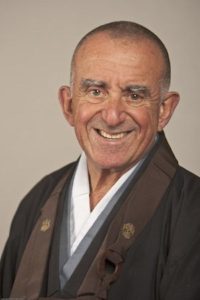I Have Nothing to Say

The Abbot’s Letter
October 2020
“I Have Nothing to Say”
This year marks the fiftieth anniversary of the publication of Zen Mind, Beginners Mind. The inspiring collection of Suzuki-roshi’s plain-speaking Dharma talks – presented at Haiku Zendo in the 1960s – introduced Zen practice and its relationship to daily life to millions of ordinary people in the U.S. and around the world. Thanks to this book, Suzuki-roshi became famous for his spoken words. Yet he had a less public dimension that eloquently expressed his wisdom in the immediacy of the present moment. The following story is one example of the quieter side of our founder.
In December, 1966, energized by Suzuki-roshi’s vision of Zen in America, San Francisco Zen Center purchased the Tassajara Hot Springs resort. In July the following year, it opened as the first Zen monastery outside of Asia. For the next several months, interest and excitement grew in the U.S. among the increasing number of scholars and writers who had been exploring Buddhism since the mid-20th century.
In August 1968, after two years of Zen practice and three months prior to moving to Haiku Zendo as resident caretakers, my family and I scheduled a three-day visit to Tassajara, open to guests during the summer. Coincidently, our weekend coincided with a significant event: the formal initiation of Suzuki-roshi’s monastery in America.
When we arrived midday Friday, an entourage of eight Japanese Zen teachers had already been at Tassajara for several days. Saturday morning was the highlight of the weekend: Suzuki-roshi and three other well-known roshis were introduced to an assembly of over 100 scholars and students, all crowded into the zendo, the converted gambling hall and bar of the early 1900s resort.
Yasutani-roshi was 83 at the time. Since 1962, he had been commuting between Japan and the U.S., conducting sesshins, never staying in one place. He was a dynamic presence, emphasizing the use of of koans, using the kyosaku (so-called “awakening stick”), yelling at students, and criticizing the Soto Zen school as being soft hearted.
Soen Nakagawa-roshi, a Rinzai priest, helped found the Dai Bosatsu monastery in the Catskills in upstate New York. Described as “enigmatic,” he was dramatic in voice and gestures.
Eido Tai Shimano, a Dharma heir of Nakagawa-roshi, founded the New York zendo and the Dai Bosatsu monastery.
Each of the three visiting roshis gave rather lengthy talks, followed by questions from the audience. When the questions ceased, a silence came over the zendo. I stood up and asked the final question: “What is the best way to spread Zen in America?” The three roshis huddled, along with Maezumi-roshi from the Los Angeles Zen Center, who was translating. He announced that each roshi would answer the question in turn.
Yasutani-roshi forcefully emphasized “Get enlightenment!” and “You must die!”
Nakagawa-roshi was vocal and demonstrative. He emphasized building zendos.
Shimano-roshi was also dynamic and dramatic, walking back and forth across the stage.
His message was: “Do sesshin!”
When it came his turn to speak, Suzuki-roshi stood up, said “I have nothing to say” and walked out the side door of the zendo.
The three guest roshis provided the kind of answers we expect in everyday affairs, rational responses to questions we ask of individuals who have more knowledge of a subject than we do.
Suzuki-roshi literally turned his back on all that.
Informative, common sense answers do not always serve us well in our efforts to find wisdom and authenticity. Zen is famous for turning away from the thought processes of a rational mind, instead responding to the moment unencumbered by memory, unexamined experiences, or an entrenched belief. Teachers abruptly reoriented a question or dialog, providing enigmatic responses without explanations. Their purpose was to keep their disciples off guard, avoiding the smugness of a well-defined answer.
So we read how Bodhidharma treated emperor Wu in China, who asks, “What is the highest truth?” Bodhidharma answers, “Vast emptiness, no holiness.” Centuries later, a monk asks Joshu: “Who is Buddha?” Joshu replies: “Who are you?”
Suzuki-roshi was mindful of how he answered questions. As he says in Zen Mind:
“A mind full of preconceived ideas, subjective intentions, or habits is not open to things as they are.”
As he walked off the stage and out of the Tassajara zendo that day in 1968, he expressed beginner’s mind with very few words. Kannon Do continues the practice begun at Haiku Zendo over fifty years ago. We are all Suzuki-roshi’s successors in the 21st century. Together, let’s continue to make his practice available to a challenging world.
Les Kaye
Abbot of Kannon Do


